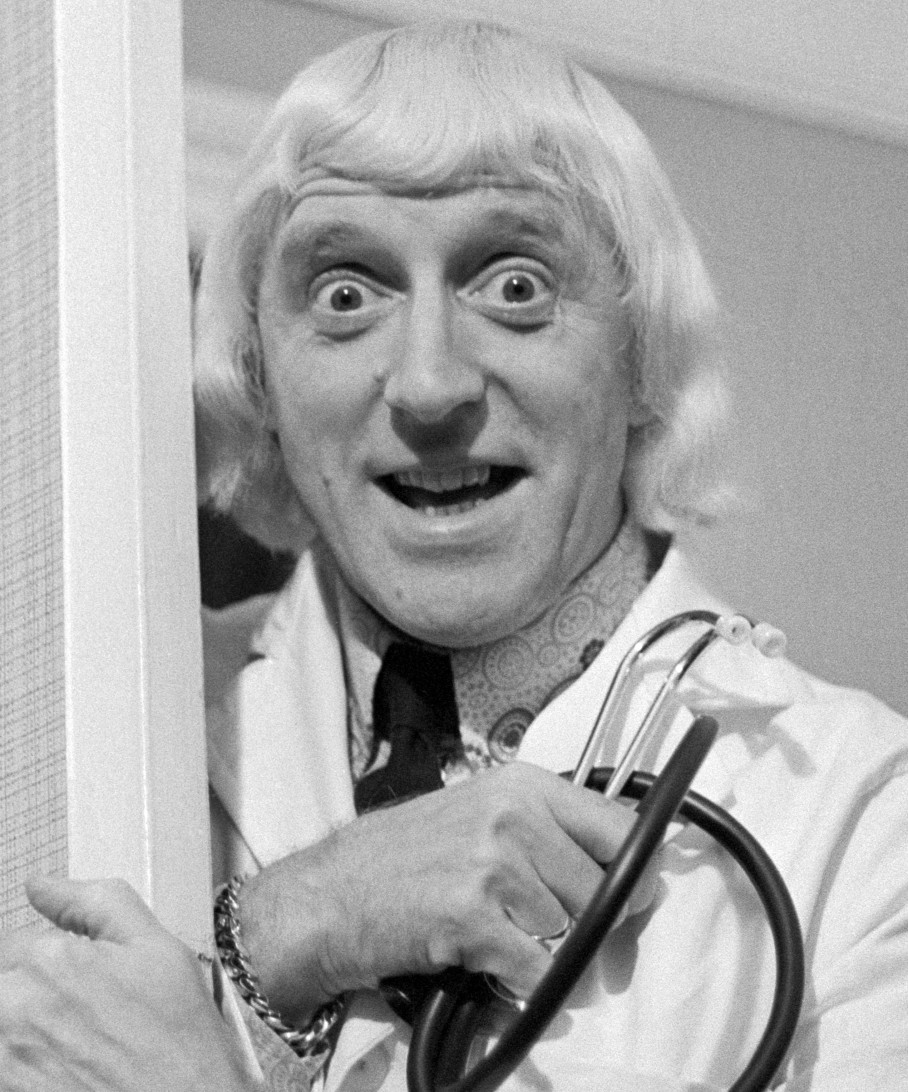How BBC Star Jimmy Savile Got Away with Allegedly Abusing 500 Children and Sex with Dead Bodies
By Terrence Mccoy
Jimmy Savile was never a handsome man. His face, even in his early days at the BBC, was all sharp edges — the hook of his nose, the jagged-tooth grin, the boggle-eyed look of eccentricity, humor and derangement. At times, he seemed almost make believe. He had platinum hair. A fat cigar perpetually hung out of his mouth. He seemed to communicate exclusively in catchphrases: “now then, now then,” “howzabout that then,” “as it ‘appens.” The kids just loved his gags. There was always something off about Savile, who hosted the BBC’s “Jim’ll Fix it,” palled around with the royal family, reportedly spent holidays with the Thatchers and was knighted not only by Queen Elizabeth but by Pope John Paul II. But most forgave his idiosyncratic nature. He was, after all, a great man. He raised $5.2 million for a hospital in Leeds, one of the United Kingdom’s largest. He volunteered countless hours as a hospital aide, busing patients to and fro. He helped scores of young doctors get their starts. Sure, there were rumors. Whispers that he wasn’t everything he seemed. Murmurs he was really a sexual predator and had abused dozens of children. But they never stuck. Not Jimmy Savile, people told themselves — not “fix-it Jim.” On October 29, 2011, Savile died at his home in Leeds. “Most of all, I remember him as just a totally flamboyant, over-the-top, larger-than-life character,” radio presenter David Hamilton told the Guardian, praising his “tireless” philanthropy. “And as he was on the air, he was just the same off.” Jimmy Savile was never a handsome man. His face, even in his early days at the BBC, was all sharp edges — the hook of his nose, the jagged-tooth grin, the boggle-eyed look of eccentricity, humor and derangement. At times, he seemed almost make believe. He had platinum hair. A fat cigar perpetually hung out of his mouth. He seemed to communicate exclusively in catchphrases: “now then, now then,” “howzabout that then,” “as it ‘appens.” The kids just loved his gags. There was always something off about Savile, who hosted the BBC’s “Jim’ll Fix it,” palled around with the royal family, reportedly spent holidays with the Thatchers and was knighted not only by Queen Elizabeth but by Pope John Paul II. But most forgave his idiosyncratic nature. He was, after all, a great man. He raised $5.2 million for a hospital in Leeds, one of the United Kingdom’s largest. He volunteered countless hours as a hospital aide, busing patients to and fro. He helped scores of young doctors get their starts. Sure, there were rumors. Whispers that he wasn’t everything he seemed. Murmurs he was really a sexual predator and had abused dozens of children. But they never stuck. Not Jimmy Savile, people told themselves — not “fix-it Jim.” On October 29, 2011, Savile died at his home in Leeds. “Most of all, I remember him as just a totally flamboyant, over-the-top, larger-than-life character,” radio presenter David Hamilton told the Guardian, praising his “tireless” philanthropy. “And as he was on the air, he was just the same off.” One woman recalled Savile sexually assaulting her when she was 16. Even decades later, she told investigators, she remembered it vividly. After he was done, he turned an imperial eye to her. “You won’t talk about this,” he told her. “Nobody will believe you. I’m Jimmy Savile. I can get you.” The girl said she told her mother, but she didn’t believe her. The girl never talked about it again. Savile, wrote Ian Robertson, a professor of psychology at Trinity College Dublin, had a “super-sense of being able to sniff out the most psychologically vulnerable who would either not tell or not be believed. … Here we have an associate of the highest echelons of British society. This halo likely acted like a protective force-field around him, not because of any collusion by any of the elite necessarily, but simply because of his repeated association with their own super-status.” In 1960, when Savile was 34, he arrived at Leeds General Infirmary to begin a relationship with the sprawling institution that would last five decades. At first, he mostly dealt in fundraising. But in 1968, he had an unusual request: He wanted to become a “porter” and bus patients. “When Mr. Savile offered his services as a voluntary porter I was a little concerned about the press implications and how he would fit into a busy teaching hospital,” a hospital director later said. “My concern was wholly unfounded and he has done an extremely good job and is accepted by all sections of the staff.” Soon Savile, who described himself as the “chief cheerer-upper” and wore and a “distinctive white coat” embroidered with his name, ingratiated himself. He assumed a greater collection of privileges that included his own parking space and nearly limitless range of the facilities. He frequently parked his camper van overnight at the hospital, and workers would dispatch 8 a.m. coffee to its door.
That power dampened some suspicion — but not all. When one woman “went to shake his hand … he took my hand and kissed me on the back of my hand then sort of multiple kisses going up my arm towards my shoulder,” she told investigators. “I didn’t feel confident enough to say, particularly because he was famous, to say, ‘That’s inappropriate.’” Then, in a flash, Savile would revert back to his television persona. His behavior — mania, dissociation with his victims, split personalities — evinces something psychologists call a “dark triad of personality characteristics.” Psychologist Oliver James wrote that Savile was likely afflicted with psychopathy, Machiavellianism and narcissism. “Such people often are able to slide effortlessly between personas. … Savile must have had a fantastical inner life — grandiose, wild and desperate.” But for the most part, that’s where it stayed: on the inside. And that obfuscation is what perhaps perpetuated the reported abuse. In a New Yorker piece on Jerry Sandusky, entitled “In Plain View: How child molesters get away with it,” Malcolm Gladwell said the most prolific pedophile is rarely the “disheveled old man baldly offering candy to preschoolers.” Rather, pedophiles can be agreeable members of the community. “People didn’t believe that [he] was a pedophile because people liked [him] — without realizing that [he] was in the business of being likeable.” And few in Britain during the 1970s and 1980s were more liked than Jimmy Savile.
|
.
Any original material on these pages is copyright © BishopAccountability.org 2004. Reproduce freely with attribution.

